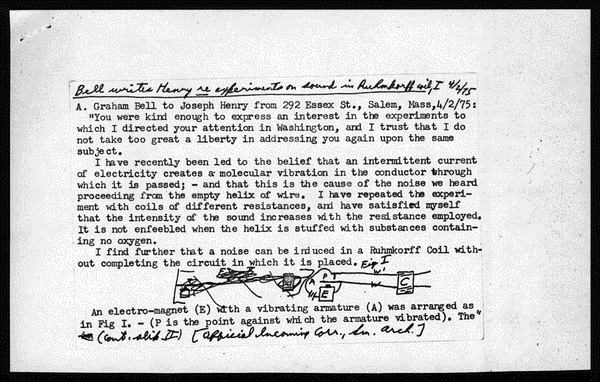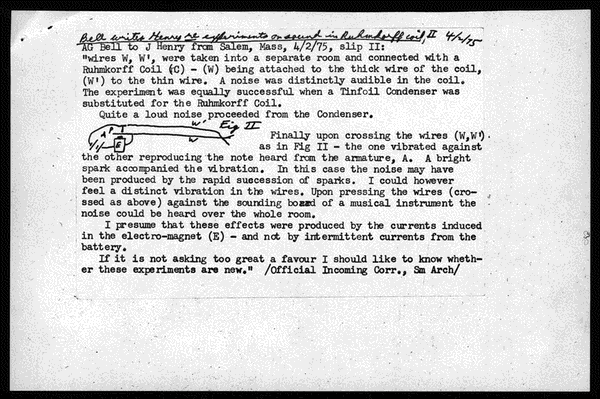| |
 |
|---|
| Henry return |
| Documents Bell |
Alexander Graham Bell |
||
| |
||
| DOCUMENTS: |
|
|
|
|
Letter from Alexander Graham Bell to Joseph Henry, April 2, 1875 | |
| Bell writers Henry re experiments on sound in Ruhmkorff coil, I 4/2/75 A. Graham Bell to Joseph Henry from 292 Essex St., Salem, Mass, 4/2/75: "You were kind enough to express an interest in the experiments to which I directed your attention in Washington, and I trust that I do not take too great a liberty in addressing you again upon the same subject. I have recently been led to the belief that an intermittent current of electricity creates a molecular vibration in the conductor through which it is passed; -- and that this is the cause of the noise we heard proceeding from the empty helix of wire. I have repeated the experiment with coils of different resistances, and have satisfied myself that the intensity of the sound increases with the resistance employed. It is not enfeebled when the helix is stuffed with substances containing no oxygen. I find further that a noise can be
induced in a
Ruhmkorff Coil without
completing the circuit in which it is placed. Illustration {Begin caption} An electro-magnet (E) with a vibrating armature (A) was arranged as in Fig I. -- (P is the point against which the armature vibrated). The {Begin handwritten}"(cont. slik II) [official incoming corr., Sr. arch.]{End handwritten} {End caption} AG Bell to J Henry from Salem, Mass, 4/2/75, slip II: "wires W, W', were taken into a separate room and connected with a Ruhmkorff Coil (C) -- (W) being attached to the thick wire of the coil, (W') to the thin wire. A noise was distinctly audible in the coil. The experiment was equally successful when a Tinfoil Condenser was substituted for the Ruhmkorff Coil. Quite a loud noise proceeded from the
Condenser. Illustration {Begin caption} {Begin handwritten}Fig II{End handwritten} {End caption} Finally upon crossing the wires (W,W') as in Fig II -- the one vibrated against the other reproducing the note heard from the armature, A. A bright spark accompanied the vibration. In this case the noise may have been produced by the rapid succession of sparks. I could however feel a distinct vibration in the wires. Upon pressing the wires (crossed as above) against the sounding board of a musical instrument the noise could be heard over the whole room. I presume that these effects were produced by the currents induced in the electro-magnet (E) -- and not by intermittent currents from the battery. If it is not asking too great a favour I should like to know whether these experiments are now." /Official Incoming Corr., Sm Arch/ |


